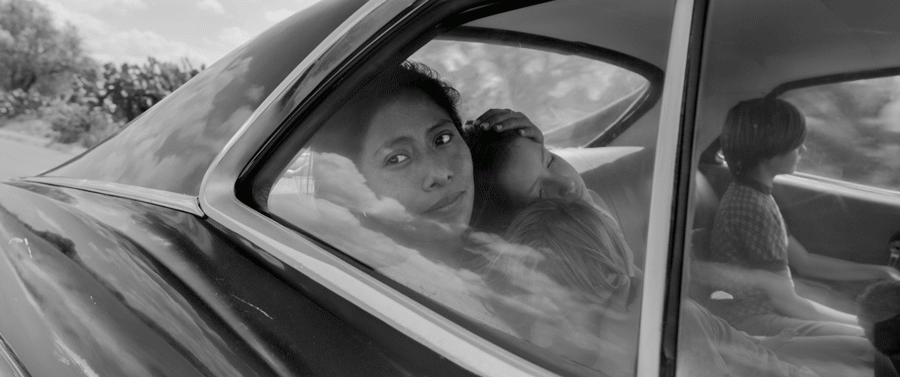Alfonso Cuarón transforms a deeply personal narrative into a universal project in “Roma”
Yalitza Aparicio as Cleo, Marco Graf as Pepe, Carlos Peralta Jacobson as Paco, and Daniela Demesa as Sofi in “Roma,” written and directed by Alfonso Cuarón
February 13, 2019
On first scan, “Roma” appears to model the elements of films that have typically flooded the Oscars’ Best Foreign Film category: a hyperlocal setting; a simple, yet striking, plotline; a handful of complex characters that jump off the screen. But “Roma” is unique in that, despite these elements, the film transcends its Mexico City roots to deliver a story that isn’t so foreign — rather, it’s a tale that is sure to resonate with audiences across the globe.
Juggling a handful of roles as the director, cinematographer, producer, writer and editor, Alfonso Cuarón (“Gravity,” “Harry Potter and the Prisoner of Azkaban”) takes a wide look at life in the slowly modernizing Mexico City. Based off Cuarón’s childhood nanny, the film focuses on Cleo, played with brilliant vulnerability by first-time actress Yalitza Aparicio, a young indigenous woman who works as a maid for a middle-class white family.
Set in the 1970s, Cuarón’s epic turns a more critical eye to the late 20th century than, say, “Bohemian Rhapsody” or “Green Book” — films that appear to disinfect and romanticize the decades prior so we may, for two hours, forget about the ongoing political moment. Cuarón, instead, takes a singular approach and focuses on the aftershocks of centuries of colonialism through the story of one woman. The use of black and white feels as though you’re witnessing history in the making, even as you are watching a simple slice of Cleo’s life.
“Roma,” named after the Roma neighborhood in Mexico City, makes the case that the issues it tackles do not just apply to this one family. There is ample use of realism here — the family’s house is located across the street from Cuarón’s childhood home. Cuarón auditioned over 3,000 women for the role of Cleo, finally landing upon Aparicio because she embodied the empathetic nature of his childhood nanny.
The movie tells its narrative in plain detail, with long, wide takes allowing the viewer to notice what is left out of the dialogue. The care with which Cleo scrubs the floors, serves food and puts the children to sleep; the cycle of verbal abuse that perpetuates from husband to wife to Cleo; the horror and sadness Cleo feels when she gives birth to a stillborn — they’re all scenes in which Cuarón uses the camera as a lens to what life is like in this moment, in this place and time.
But the film’s setting does not make its themes feel any less pressing. It uses its two main female characters, Cleo and Sofía — the struggling matriarch of the family — to mirror one another as the men in their lives betray and abandon them. The women build each other up, despite their flaws, to keep the family whole. These are not problems that are relegated to a black and white history book; these issues plague women across the world, no matter the socioeconomic context, their race or background. Even the abject pain Cleo suffers while holding her stillborn child to the revelation that she did not want this child in the first place is a shared emotion in the female consciousness. That scene is not one I will soon forget.
“Roma” is up for a number of accolades this year at the 91st Academy Awards, tied with “The Favourite” for ten nominations apiece, many of them historic. Aparicio is the first indigenous woman to be nominated for Best Actress. The film is tied with “Crouching Tiger, Hidden Dragon” (2000) for most nominations for a foreign language film. It is also only the tenth foreign language film to be nominated for Best Picture — if it wins, it will become the first foreign language film ever to go home with the top prize.
Giving “Roma” the Best Picture award would reward not only Cuarón for his deft filmmaking, but other artists who use film as a medium to depict a more accurate landscape of the world. As Hollywood has become ensnared in scandal — from #OscarsSoWhite to #MeToo — viewers have been demanding more representation in film.
According to UCLA’s 2018 Hollywood Diversity Report, women made up 31.2 percent of leads in top films, and minorities made up a mere 13.9 percent (the latter would have to triple to reach proportional representation). “Roma” turns its lens onto a often glanced-over slice of society, giving the story the attention and artistic treatment it deserves.
Even more so, the Oscars should honor this movie’s authenticity. Its seemingly ordinary narrative, the use of native language and its grounding in reality all combine to craft a story that transcends one woman. It shows how we all struggle, how people let us down. The film gives you a slice of Cleo’s life — her pain and her fortitude — and hopes you learn something from it. I just hope the Academy does, too.
Email: [email protected]
Twitter: @charwalsh_


